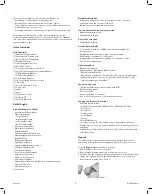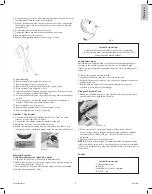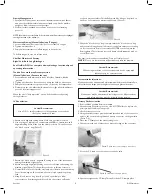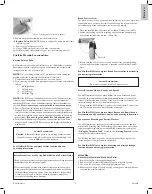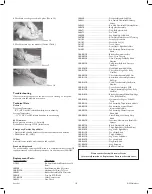
encouraged to attempt correction of the interference by:
• Reorienting or relocating the receiving antenna.
• Increasing the distance between the device and receiver.
• Connecting the device to an outlet on a circuit different from that to
which the receiver is connected.
• Consulting the dealer or an experienced radio/TV technician for help.
Electromagnetic radiation from other radio transmitters or other
electronic equipment may cause noise in the head speaker. To eliminate
this noise, move manikin away from the radiation source or turn the head
speaker volume to zero.
Items Included:
ALS Simulator
(1) Adult, Full-body Simulator
(1) Articulating IV Training Arm
(1) Blood Pressure Training Arm
(1) Manikin Lubricant
(1) Interchangeable Pupil Set
(6) Neck Skin Collars
(1) Cricothyroid Membrane Tape Roll
(1) Set of Replacement Pneumothorax Bladders
(2) Mid-Clavicular Bladders
(2) Mid Axillary Bladders
(6) Chest Drain Modules
(1) 10 Foot Manikin Connector Cable
(1) Air Pump
(1) Set of Defibrillation Posts
(1) Carry Case
(1) Jacket
(1) Pants
(1) Directions for Use
(1) Software CD
(1) Learning Materials
Skills Taught:
Airway Management Skills
• Assessment of Respirations
• Obstructed airway
• Tongue Edema
• Right Lung Blockage
• Left Lung Blockage
• Both Lung Blockage
• Endotracheal intubation
• Nasotracheal intubation
• Digital intubation
• Oropharyngeal airway insertion
• Nasopharyngeal airway insertion
• Bag Valve Mask
• Retrograde intubation
• Lightwand intubation
• Laryngeal Mask Airway insertion
• Laryngeal Tube Insertion
• Combitube insertion
• Trans-Tracheal Jet Ventilation
• Surgical cricothyrotomy
• Needle cricothyrotomy
• Suctioning techniques
• Stomach auscultation to verify proper airway positioning
• Head Tilt/Chin Lift
• Modified Jaw thrust
• Ventilations
Drug Administration
• IV insertion, infusion and bolus into peripheral veins of forearm,
antecubital fossa and dorsum of the hand
• Subcutaneous and intramuscular injections
Tension Pneumothorax Decompression
• Bilateral mid-clavicular sites
• Mid-axillary site (Right)
Chest Tube Insertion
• Mid-axillary site (Left)
Cardiac Related Skills
• 3 – 4 lead ECG with over 1400 rhythm variations available for
interpretation.
• Pacing with variable threshold, with or without capture
• Defibrillation capabilities (25 -360 joules)
• Programmable scenario base algorithms for instructor control
• Closed chest compressions
Circulatory Skills
• Bilateral carotid pulse
• Measurement of Noninvasive Blood Pressure
- Brachial and radial pulses
- Auscultation or palpation of noninvasive blood pressure measurement
- VitalSim allow values to be set for systolic, diastolic pressures, heart
rate, auscultatory gap and volume
Sounds and Speech
• 13 different heart sounds synchronized with ECG
• 8 different lung sounds
• 5 bowel sounds
• 9 preprogrammed vocal sounds
• Live voice through the use of a wireless microphone
Logging and Scenario Functions
• Sensored Events Include:
• Airway Opened via Head Tilt/Chin Lift or Modified Jaw Thrust
• Pulse check
• Ventilations
• Compressions
• Defibrillation
• Pacing
• Customizable Events
• PC scenario editor for user defined and pre-programmed scenarios.
• Student logs can be stored and downloaded for post training review and
debriefing.
• VitalSim Control Unit will hold up to ten (10) scenarios and twenty-five
(25) student logs.
Unpack:
The ALS Simulator is packaged without the legs attached. Remove the
upper body and legs from the packaging and attach the legs to the torso.
To attach
Right Leg
(with enclosed air tank):
1. Remove bladder reservoir from pelvis.
2. Remove blank genitalia module from pelvic region of torso.
3. Carefully slide the tubing and wiring exiting the fixed bolt from the upper
thigh of the right leg through the abdominal connector hole and into
internal cavity of pelvic area. (Photo 1)
Photo 1
Laerdal
4
ALS Simulator


